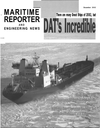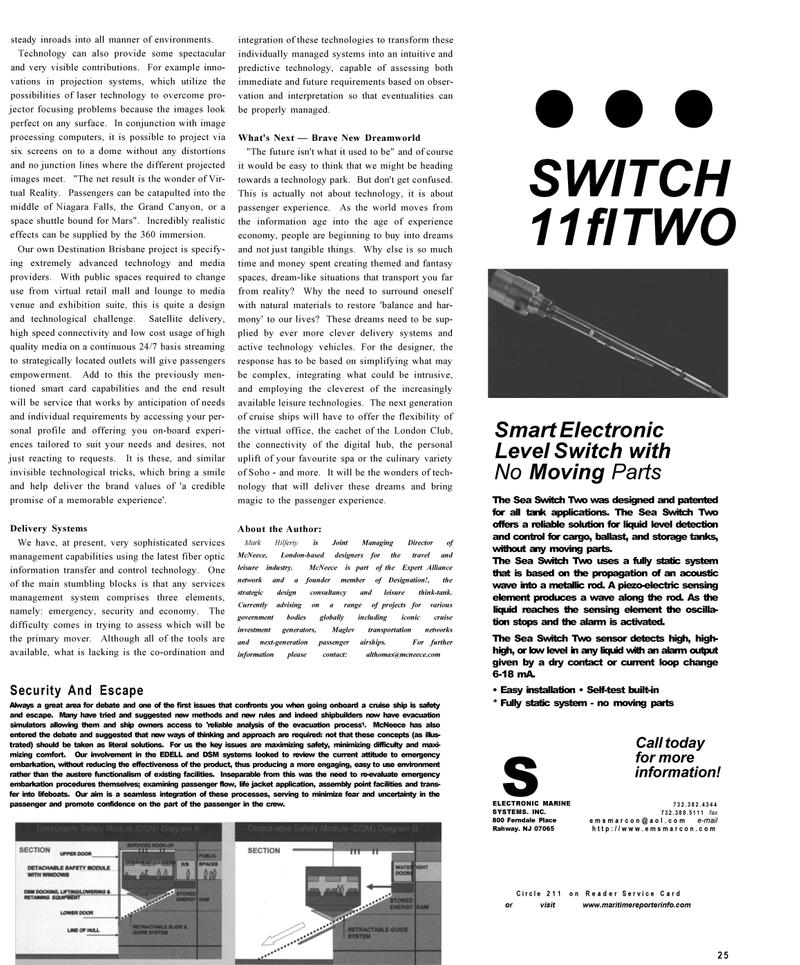
Page 25: of Maritime Reporter Magazine (December 2002)
Read this page in Pdf, Flash or Html5 edition of December 2002 Maritime Reporter Magazine
steady inroads into all manner of environments.
Technology can also provide some spectacular and very visible contributions. For example inno- vations in projection systems, which utilize the possibilities of laser technology to overcome pro- jector focusing problems because the images look perfect on any surface. In conjunction with image processing computers, it is possible to project via six screens on to a dome without any distortions and no junction lines where the different projected images meet. "The net result is the wonder of Vir- tual Reality. Passengers can be catapulted into the middle of Niagara Falls, the Grand Canyon, or a space shuttle bound for Mars". Incredibly realistic effects can be supplied by the 360 immersion.
Our own Destination Brisbane project is specify- ing extremely advanced technology and media providers. With public spaces required to change use from virtual retail mall and lounge to media venue and exhibition suite, this is quite a design and technological challenge. Satellite delivery, high speed connectivity and low cost usage of high quality media on a continuous 24/7 basis streaming to strategically located outlets will give passengers empowerment. Add to this the previously men- tioned smart card capabilities and the end result will be service that works by anticipation of needs and individual requirements by accessing your per- sonal profile and offering you on-board experi- ences tailored to suit your needs and desires, not just reacting to requests. It is these, and similar invisible technological tricks, which bring a smile and help deliver the brand values of 'a credible promise of a memorable experience'.
Delivery Systems
We have, at present, very sophisticated services management capabilities using the latest fiber optic information transfer and control technology. One of the main stumbling blocks is that any services management system comprises three elements, namely: emergency, security and economy. The difficulty comes in trying to assess which will be the primary mover. Although all of the tools are available, what is lacking is the co-ordination and integration of these technologies to transform these individually managed systems into an intuitive and predictive technology, capable of assessing both immediate and future requirements based on obser- vation and interpretation so that eventualities can be properly managed.
What's Next — Brave New Dreamworld "The future isn't what it used to be" and of course it would be easy to think that we might be heading towards a technology park. But don't get confused.
This is actually not about technology, it is about passenger experience. As the world moves from the information age into the age of experience economy, people are beginning to buy into dreams and not just tangible things. Why else is so much time and money spent creating themed and fantasy spaces, dream-like situations that transport you far from reality? Why the need to surround oneself with natural materials to restore 'balance and har- mony' to our lives? These dreams need to be sup- plied by ever more clever delivery systems and active technology vehicles. For the designer, the response has to be based on simplifying what may be complex, integrating what could be intrusive, and employing the cleverest of the increasingly available leisure technologies. The next generation of cruise ships will have to offer the flexibility of the virtual office, the cachet of the London Club, the connectivity of the digital hub, the personal uplift of your favourite spa or the culinary variety of Soho - and more. It will be the wonders of tech- nology that will deliver these dreams and bring magic to the passenger experience.
About the Author:
Mark Hilferty is Joint Managing Director of
McNeece, London-based designers for the travel and leisure industry. McNeece is part of the Expert Alliance network and a founder member of Designation!, the strategic design consultancy and leisure think-tank.
Currently advising on a range of projects for various government bodies globally including iconic cruise investment generators, Maglev transportation networks and next-generation passenger airships. For further information please contact: [email protected]
Security And Escape
Always a great area for debate and one of the first issues that confronts you when going onboard a cruise ship is safety and escape. Many have tried and suggested new methods and new rules and indeed shipbuilders now have evacuation simulators allowing them and ship owners access to 'reliable analysis of the evacuation process1. McNeece has also entered the debate and suggested that new ways of thinking and approach are required: not that these concepts (as illus- trated) should be taken as literal solutions. For us the key issues are maximizing safety, minimizing difficulty and maxi- mizing comfort. Our involvement in the EDELL and DSM systems looked to review the current attitude to emergency embarkation, without reducing the effectiveness of the product, thus producing a more engaging, easy to use environment rather than the austere functionalism of existing facilities. Inseparable from this was the need to re-evaluate emergency embarkation procedures themselves; examining passenger flow, life jacket application, assembly point facilities and trans- fer into lifeboats. Our aim is a seamless integration of these processes, serving to minimize fear and uncertainty in the passenger and promote confidence on the part of the passenger in the crew. •••
SWITCH 11 fl TWO
Smart Electronic
Level Switch with
No Moving Parts
The Sea Switch Two was designed and patented for all tank applications. The Sea Switch Two offers a reliable solution for liquid level detection and control for cargo, ballast, and storage tanks, without any moving parts.
The Sea Switch Two uses a fully static system that is based on the propagation of an acoustic wave into a metallic rod. A piezo-electric sensing element produces a wave along the rod. As the liquid reaches the sensing element the oscilla- tion stops and the alarm is activated.
The Sea Switch Two sensor detects high, high- high, or low level in any liquid with an alarm output given by a dry contact or current loop change 6-18 mA. • Easy installation • Self-test built-in * Fully static system - no moving parts
Call today for more information! 732.382.4344 732.388.5111 fax [email protected] e-mail http://www.emsmarcon.com
Circle 211 on Reader Service Card or visit www.maritimereporterinfo.com 25
S
ELECTRONIC MARINE
SYSTEMS. INC. 800 Ferndale Place
Rahway. NJ 07065

 24
24

 26
26
